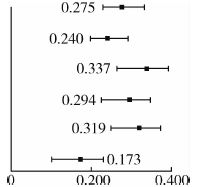Journal of Peking University (Health Sciences) ›› 2021, Vol. 53 ›› Issue (3): 560-565. doi: 10.19723/j.issn.1671-167X.2021.03.020
Previous Articles Next Articles
Impact of health literacy on patient experience of outpatients in China and its mechanism
WANG Xiao-qi1,CHEN Mei-jun1,YUN Qing-ping1,SUN Si-wei1,2,WANG Xi-kai3,SHI Yu-hui1,JI Ying1,GUAN Zhong-jun3,CHANG Chun1,Δ( )
)
- 1. Department of Social Medicine and Health Education, Peking University School of Public Health, Beijing 100191, China
2. Peking University Sixth Hospital, Beijing 100191, China
3. School of Health Management and Education, Capital Medical University, Beijing 100069, China
CLC Number:
- R193
| [1] | Purcarea Th. V. Creating the ideal patient experience[J]. J Med Life, 2016,9(4):380-385. |
| [2] |
Male L, Noble A, Atkinson J, et al. Measuring patient experience: A systematic review to evaluate psychometric properties of patient reported experience measures (PREMs) for emergency care service provision[J]. Int J Qual Health Care, 2017,29(3):314-326.
doi: 10.1093/intqhc/mzx027 |
| [3] |
Gillespie H, Kelly M, Gormley G, et al. How can tomorrow’s doctors be more caring? A phenomenological investigation[J]. Med Educ, 2018,52(10):1052-1063.
doi: 10.1111/medu.13684 pmid: 30255523 |
| [4] | Yim CK, Shumate L, Barnett SH, et al. Health literacy assessment and patient satisfaction in surgical practice[J]. Ann Med Surg (Lond), 2018,35:25-28. |
| [5] |
Aoki T, Inoue M. Association between health literacy and patient experience of primary care attributes: A cross-sectional study in Japan[J]. PLoS One, 2017,12(9):e0184565.
doi: 10.1371/journal.pone.0184565 |
| [6] | 张建洁, 李金林, 曹雪丽. 患者就医满意度影响因素的实证分析[J]. 北京理工大学学报(社会科学版), 2018,20(1):102-109. |
| [7] |
Andersen RM. Revisiting the behavioral model and access to medical care: Does it matter?[J]. J Health Soc Behav, 1995,36(1):1-10.
pmid: 7738325 |
| [8] | Andersen RM. Changing the U.S. Health Care System[M]. 3rd ed. New Jersey: John Wiley & Sons Inc., 2007: 1-30. |
| [9] | Squiers L, Peinado S, Berkman N, et al. The health literacy skills framework[J]. J Health Commun, 2012,17(3):30-54. |
| [10] |
Jordan J, Buchbinder R, Briggs A, et al. The health literacy ma-nagement scale (HeLMS): A measure of an individual’s capacity to seek, understand and use health information within the healthcare setting[J]. Patient Educ Couns, 2013,91(2):228-235.
doi: 10.1016/j.pec.2013.01.013 |
| [11] |
Hu G, Chen Y, Liu Q, et al. Patient experience of hospital care in China: Major findings from the Chinese patient experience questionnaire survey (2016-2018)[J]. BMJ Open, 2019,9(9):e031615.
doi: 10.1136/bmjopen-2019-031615 |
| [12] | 肖水源. 《社会支持评定量表》的理论基础与研究应用[J]. 临床精神医学杂志, 1994(2):98-100. |
| [13] | Wynia MK, Osborn CY. Health literacy and communication quality in health care organizations[J]. J Health Commun, 2010,15(2):102-115. |
| [14] | Schwartzberg JG, Cowett A, VanGeest J, et al. Communication techniques for patients with low health literacy: A survey of physicians, nurses, and pharmacists[J]. Am J Health Behav, 2007,31(1):S96-S104. |
| [15] |
Altin SV, Stock S. Impact of health literacy, accessibility and coordination of care on patient’s satisfaction with primary care in Germany[J]. BMC Fam Pract, 2015,16(1):148.
doi: 10.1186/s12875-015-0372-0 |
| [16] |
Altin SV, Stock S. The impact of health literacy, patient-centered communication and shared decision-making on patients’ satisfaction with care received in German primary care practices[J]. BMC Health Serv Res, 2016,16(1):450.
doi: 10.1186/s12913-016-1693-y |
| [17] |
Inoue M, Takahashi M, Kai I. Impact of communicative and critical health literacy on understanding of diabetes care and self-efficacy in diabetes management: A cross-sectional study of primary care in Japan[J]. BMC Fam Pract, 2013,14(1):40.
doi: 10.1186/1471-2296-14-40 |
| [1] | Shuangyun ZHAO, Siyu ZOU, Xueying LI, Lijuan SHEN, Hong ZHOU. Evaluation of reliability and validity of Chinese version of a short-form of Health Literacy Dental scale (HeLD-14) in the application among parents of preschool children [J]. Journal of Peking University (Health Sciences), 2024, 56(5): 828-832. |
| [2] | Hejun SHEN,Chongyan SHI,Qing ZHENG,Yu HUANG,Tao JING. Investigation on the current situation and influencing factors of sitting time and health literacy among high school students in China [J]. Journal of Peking University (Health Sciences), 2024, 56(2): 239-246. |
| [3] | ZHANG Hong,DONG Ji-yuan,WANG Jian-jun,FAN Lin-xia,QU Qiang,LIU Yang. Short-term effects and seasonal variation of ozone on daily hospital outpatient visits for childhood asthma in Lanzhou [J]. Journal of Peking University (Health Sciences), 2022, 54(2): 227-235. |
| [4] | BI Shu-hong,LI Zi-fan,WANG Tao,WANG Yue,ZHANG Chen,JI Hong,SHI Ju. Trend in medical expenditures for patients with kidney diseases: An analysis from a tertiary hospital in Beijing [J]. Journal of Peking University (Health Sciences), 2021, 53(1): 215-219. |
| [5] | Wei-yu ZHANG,Qiu-xiang XIA,Hao HU,Jing-wen CHEN,Yi-ran SUN,Ke-xin XU,Xiao-peng ZHANG. Analysis of urodynamic study of female outpatients with lower urinary tract symptoms and follow-up of the patients with detrusor underactive [J]. Journal of Peking University(Health Sciences), 2019, 51(5): 856-862. |
| [6] | ZHANG Hu-yang, JIAN Wei-yan, FANG Hai. Analysis of substitutional effect of outpatient expenditure on inpatient expenditure in hypertensive patients with rural new cooperative medical scheme [J]. Journal of Peking University(Health Sciences), 2016, 48(3): 472-477. |
| [7] | WANG Pin-Ze, LIU Min, DAI Xiao-Qiu, YANG Xue-Song, HAI Shan-·Ka-De-尔Bai, LI Xiao-Guang, SHEN Li, WANG Zheng-Hui, WU Hua, XU Jie, NING Yong-Zhong. Establishment of early warning control charts based on the syndromic surveillance data of outpatient diarrhea in Beijing [J]. Journal of Peking University(Health Sciences), 2014, 46(3): 424-428. |
|
||


